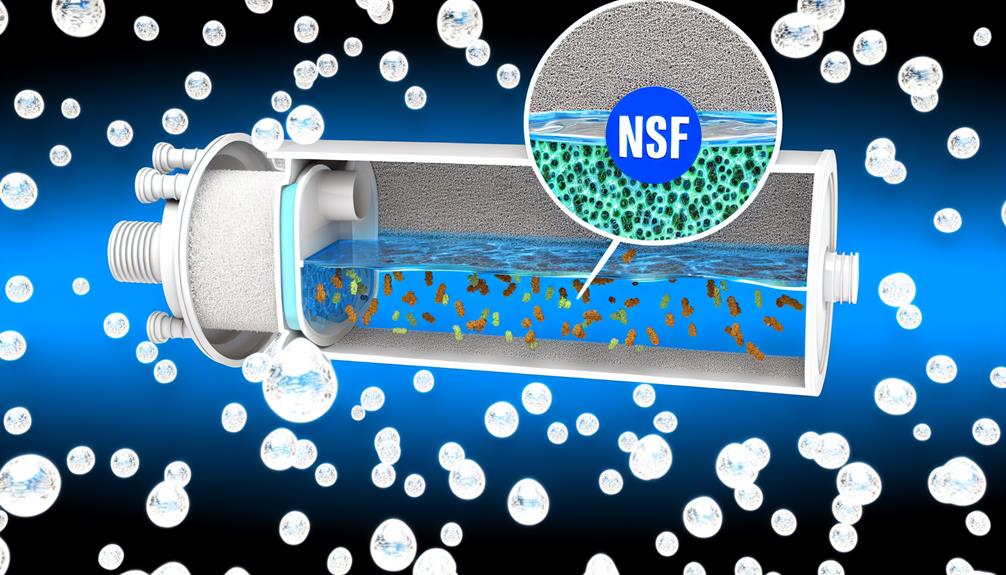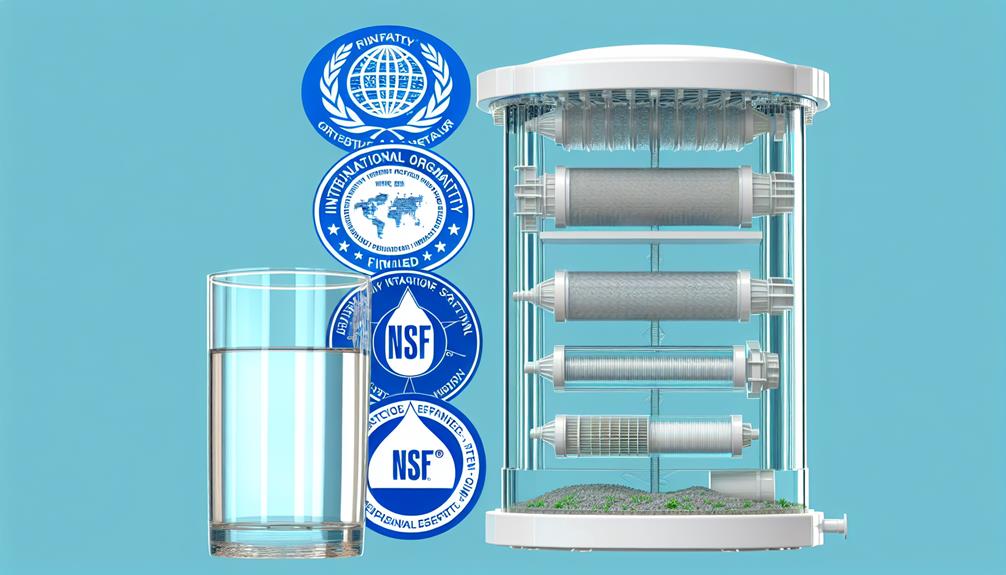Navigating through the EU water filter compliance standards can be like threading a needle—precise and requiring careful attention to detail. You need to ensure that the water filters you rely on meet stringent criteria for health and safety, which is why understanding these standards is crucial.
They serve as a roadmap, guiding manufacturers and consumers alike towards products that not only promise but deliver on quality and safety. Among these standards, the EU Drinking Water Directive and CE Marking Requirements are just the tip of the iceberg.
As you sift through the complexities of Water Quality Standards EN 13443, ETV Verification Process, and others, you'll discover layers of regulations each filter must pass to earn a place in the market—and in your home.
This exploration will equip you with the knowledge to make informed decisions, ensuring the water you consume is of the highest standard. So, have you ever wondered what it takes for a water filter to be considered amongst the best in compliance with EU standards?
Let's explore the criteria that set the benchmarks for excellence.
EU Drinking Water Directive
The EU Drinking Water Directive mandates rigorous standards to ensure the safety and quality of drinking water throughout the member states, demanding regular monitoring and precise limits on contaminants. It's designed to protect your health by requiring EU member states to regulate drinking water systems meticulously.
Under the revised 2020 directive, you'll find new or updated parametric values. These cover a comprehensive range of microbiological, chemical, and indicator parameters. It's analytical precision at its finest, with the primary aim to safeguard your fundamental right to access fresh, clean potable water, as championed by the 'Right2Water' initiative.
Moreover, the directive emphasizes the critical role of filtration performance and the effectiveness of disinfection processes. If you're considering a water filter for your home, you need to check for NSF certification, a mark ensuring that the product meets strict health and safety standards. This certification aligns with the EU's commitment to quality, providing an additional layer of assurance for you and your family's drinking water safety.
CE Marking Requirements
You must navigate the CE certification process with precision to ensure your water filters meet all relevant European Directives.
It's critical to understand that the validity of the CE mark hinges on thorough verification and adherence to the specific directives applicable to your product.
Failure to comply with these standards can result in your product being barred from the European market, underscoring the importance of meticulous conformity assessment.
CE Certification Process
Navigating the CE Certification Process requires manufacturers to meticulously assess their products against stringent EU safety, health, and environmental protection standards before entering the European market.
You'll need to:
- Identify applicable directives and standards
- For water filters, this might include compliance with NSF/ANSI Standards that align with EU regulations.
- Conduct a thorough conformity assessment
- Compare your product with the EU requirements and existing national standards.
- Compile a technical file and issue a Declaration of Conformity
- Document your compliance journey, ensuring all criteria are met and traceable.
Your analytical approach should mirror the precision of the European Parliament's directives. By mastering the CE certification process, you ensure your water filters can freely circulate within the EEA, upholding high-quality filtration standards.
Marking Validity and Verification
Having mastered the CE certification process, it's now crucial to ensure that the CE marking on your water filters is valid, verifiable, and in strict adherence to EU legislation. Your filtration systems must be rigorously tested and certified to meet the high water quality standards expected within the EEA. As a manufacturer, you're responsible for the conformity assessment and for maintaining comprehensive technical documentation.
Affix the CE mark visibly, legibly, and indelibly to your products. It's also prudent to consider NSF certification as an additional testament to your commitment to quality. Always keep your compliance records up-to-date, as market surveillance authorities may require evidence of your filters' compliance.
Ensuring the CE marking's validity protects both your business and the consumers relying on the safety of your water filtration systems.
Water Quality Standards EN 13443
Water Quality Standards EN 13443 play a pivotal role in certifying that filtration systems effectively purify drinking water within the European Union. When you're selecting a filtration product, it's essential to understand the implications of these standards on water quality:
- Performance Criteria:
- Reduction of contaminants, ensuring water is safe to consume.
- Structural integrity, preventing material breakdown that could compromise water quality.
- Safety of materials, safeguarding against harmful substances leaching into your drinking water.
- Compliance Significance:
- Ensures filtration products meet stringent health and safety requirements.
- Aligns with NSF standards, recognized internationally for water treatment.
- Provides a benchmark for comparing the efficacy of different filtration systems.
- Consumer Guidance:
- Detailed installation instructions to facilitate proper use.
- Clear marking and information from manufacturers.
- Helps you make informed decisions based on transparent product performance.
ETV Verification Process
You must comprehend the ETV criteria overview to grasp how it bolsters the legitimacy of environmental technologies.
The verification steps are meticulously explained, ensuring independent evaluators assess the technology's performance accurately and thoroughly.
Understanding the ETV's impact on standards allows you to appreciate its role in harmonizing water filter compliance across the EU.
ETV Criteria Overview
To ensure the efficacy and environmental benefits of novel water filtration technologies, the ETV Criteria Overview mandates a rigorous verification process involving independent third-party assessment. This process is essential for maintaining water quality and adhering to the standard intended for human consumption. Here's what you need to know:
- Performance Evaluation
- *Reliability*: Consistent operation at the point of use.
- *Effectiveness*: Proven removal of contaminants.
- *Water Treatment*: Meets specific purification benchmarks.
- Independent Assessment
- Ensures unbiased verification.
- Validates claims against established criteria.
- Environmental Benefits
- Quantifies ecological impact.
- Supports sustainability in water resource management.
Verification Steps Explained
Understanding the ETV verification process is crucial as it delineates the systematic approach to authenticating a water filtration system's performance and safety. This standard includes detailed protocols to evaluate water filters, ensuring they adequately remove contaminants and maintain water quality.
The verification steps explained are methodical and analytical, starting with an assessment of material safety to negate any potential toxicological effects. Third-party organizations then rigorously test the filters, analyzing their contaminant reduction capabilities against established benchmarks.
Compliance with relevant regulations is next, verifying that the system adheres to stringent EU standards. Ultimately, this process certifies that the water filters provide consumers with the assurance of clean and safe drinking water.
ETV Impact on Standards
The ETV verification process significantly shapes the evolution of water filter standards by rigorously evaluating a system's environmental performance and compliance with EU regulations.
You'll find that the ETV's role in shaping standards is multifaceted:
- Influence on Market Confidence
- Validates performance claims of water filtration products
- Ensures systems effectively reduce disinfection byproducts
- Regulatory Acceptance
- Promotes alignment with EU directives
- Encourages the integration of innovative solutions like activated carbon technology
- Standard Development
- Offers insights for new or enhanced guidelines
- Drives the establishment of stringent water quality benchmarks
Regulation (EC) No 1935/2004
Harmonization of EU member states' laws concerning materials and articles in contact with food is the cornerstone of Regulation (EC) No 1935/2004, which mandates consistency in compliance documentation and traceability. This regulation ensures that the quality of water intended for human consumption isn't compromised by the materials it comes into contact with throughout its journey.
As you delve deeper into the specifics, you'll find that Regulation (EC) No 1935/2004 lays down general principles to uphold food safety and protect public health.
Every material that may affect water quality, including those used in water filtration systems, must comply. However, you'll notice that complex items like water filters aren't fully defined at a European level, which can be challenging. You have to ensure that the materials used in these systems don't release substances into the water in quantities that could pose a risk to health.
To navigate these challenges, you might seek declarations from respected bodies that assure compliance with the regulation. By doing so, you're taking necessary steps to ensure that the water quality and food safety standards are met, safeguarding public health within the EU.
EU Microplastics Guidelines
Building on the foundation of ensuring water safety through Regulation (EC) No 1935/2004, you must now consider how the EU Microplastics Guidelines further protect human health by setting stringent controls on microplastic contamination in drinking water. These guidelines are pivotal in maintaining high water quality standards and safeguarding public health against the insidious threat posed by microplastics.
The guidelines' objectives are:
- Reduction: To minimize microplastic levels in water sources.
- Regulation: To enforce legal limits on microplastics in drinking water.
- Monitoring: To mandate consistent testing and reporting.
- *Testing*: Regular analysis of water samples for microplastic particles.
- *Reporting*: Detailed accounts of microplastic concentrations in water.
- *Compliance*: Ensuring water suppliers meet or exceed set standards.
Your role in this is critical. You're tasked with implementing filtration solutions, like reverse osmosis systems, that can effectively remove microplastics from water supplies. By doing so, you ensure that the water reaching consumers isn't just clear, but also clean on a microscopic level—free from plastic contaminants that can compromise health.
Complying with these EU Microplastics Guidelines isn't just about meeting regulatory demands—it's about prioritizing the health of individuals and the collective well-being of society.
REACH Compliance for Filters
You must ensure that any water filters you manufacture or import comply with the EU's REACH regulations to safeguard both human health and the environment from potential chemical risks. REACH compliance isn't a mere formality; it's a stringent and comprehensive process that demands a thorough understanding of the chemical substances involved in your water quality systems.
When it comes to filter elements within your water filters, you're responsible for gathering extensive data on their chemical properties. This crucial step can't be overlooked, as it forms the basis for registration with the European Chemicals Agency (ECHA). Your commitment to compliance signifies that your filters meet the highest standards for safety and efficacy in water filtration.
Moreover, as a manufacturer or importer, your obligations under REACH extend beyond registration. You must also ensure the communication of safe use instructions throughout the supply chain and directly to the end-users. This requirement isn't only regulatory but also an ethical imperative to facilitate informed and safe usage of water filters.
WFD and Groundwater Directives
While the REACH regulations focus on the chemical aspects of water filtration products, the Water Framework Directive (WFD) and the Groundwater Directive expand the scope of protection to encompass the broader environmental and public health implications of water quality management in the EU. As a stakeholder in the Water Industry, you're responsible for not only adhering to these directives but also understanding their impact on ground water and water quality.
The WFD aims to:
- Protect and enhance the status of aquatic ecosystems
- Promote sustainable water usage based on long-term protection of available resources
- Reduce pollutants in water bodies, ensuring that marine environments meet surface water standards
The Groundwater Directive focuses on:
- Preventing and controlling ground water pollution
- Establishing comprehensive monitoring networks to detect pollutants
- Implementing measures to prevent or limit the input of hazardous substances
Compliance involves:
- Developing robust management plans tailored to each water body
- Engaging in public information sharing and consultation
- Monitoring, assessing, and reporting water quality to ensure the sustainability of water resources

